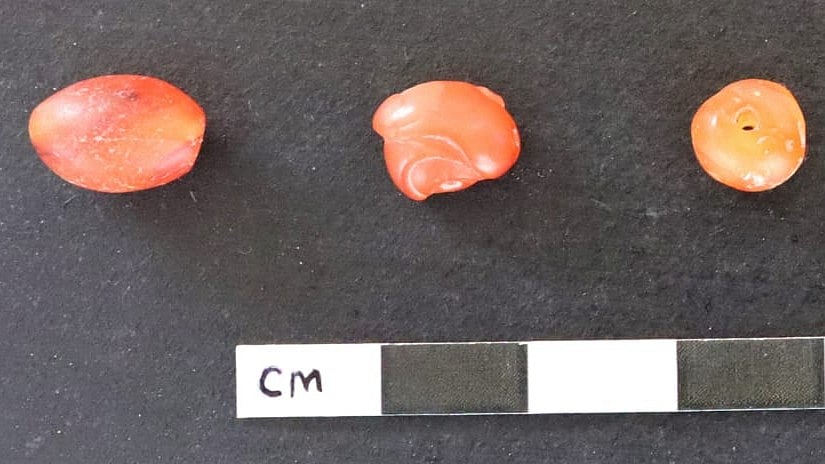
Objects excavated.
Credit: Special Arrangement
Vembakottai: When archaeologists from the Tamil Nadu State Department of Archaeology (TNSDA) began digging at Vembakottai on the north banks of Vaippar River in 2022, they were expecting to unearth raw materials, tools, and artefacts from the Microlithic Age onwards.
But what they chanced upon in the last three years is overwhelming evidence of the existence of an industrial unit that manufactured shell bangles and glass beads, at least 2,000 years ago.
Not just that, antiquities unearthed in the three phases of excavation so far reveal the workmanship of the ancient Tamil who excelled in the art of engraving and decorating shell bangles and ornaments with unique designs.
Located about 100 km from Keeladi, the Sangam-era site which is at least 2,600 years old, Vembakottai in Virudhunagar district is emerging as a one of the prime archaeological sites in Tamil Nadu. It has been scientifically proven iron started being used as early as 3345 BCE (5,300 years ago).
Though the site hasn’t been dated yet, archaeologists believed it could be at least 2,000 years old and have sent samples for scientific analyses.
Glass and shell manufacturing
“Vembakottai continues to bewilder us. We did find core Microlithic materials like chert as expected but what is clear now is the presence of a thriving unit that made glass beads and shell bangles,” excavation director Pon Baskar said as he took the DH correspondent around the trenches to explain the meticulous nature of the craftsmanship of the inhabitants.
Shell ornaments with intricate designs
Credit: Special Arrangement
Believed to be part of the famed Pandya Kingdom, Vembakottai has yielded a rich collection of antiquities with the total number reaching about 12,000. While 3,254 antiquities were unearthed in the first phase, the number rose to 4,660 in the second phase, and the figure is 4,056 so far in the third phase, which will end in a few weeks. In total, 56 trenches were dug.
Glass beads in various colours dominate the unearthed antiquities (7,000), shell beads and ornaments of different models (over 2,500), even as different types of potteries, and iron, copper, and gold objects like chisels, have also been unearthed.
Cut stones, jasper and chert stones, flake and fluted core materials, glass bangles, terracotta beads, spindle whorls, terracotta gamesmen, smoking pipes, terracotta pendant, toy objects, terracotta figurines, and terracotta weighing units, have also been found.
Meticulous artistry of inhabitants
Baskar told DH he never witnessed such scrupulous nature of artistry in ornaments discovered from excavations in the past with almost 20 per cent of the shell bangles decorated with red accede paint.
“The inhabitants have used rubbing stone and grinding stone to polish the shells and lime water to reduce their roughness. The ornaments and glass beads they manufactured at Vembakottai were meant mostly for exports,” he added.
The officer said the inhabitants used pendants and ornaments made of terracotta for their own use. They also used terracotta to make figurines of male, female, and animals, which could have been their pastime.
Terracotta Figurine
Credit: Special Arrangement
Another distinct finding from Vembakottai is about 10 terracotta figurines that resemble Hyperboreans, an integral part of Greek mythology, which could hint at trade links. A terracotta figurine of a humped bull like the one found in Keeladi has also been unearthed.
Vembakottai was one of the huge habitation sites chosen for excavation and there is evidence to show continuous habitation from early historic period to Medieval period.
“We expected Vembakottai to be a pure Microlithic site but what we got is mixed results. Shell making was a common industry then and we have found cut stones that are used to cut shells in Vembakottai which shows the industry thrived there,” Baskar added.
Connections with Pattanamarudur
R Bharath Kumar, co-director of Vembakottai excavations, said it is believed that people here might have received shells from Pattanamarudur in present-day Thoothukudi district as villagers there are still involved in shell trade.
“It is not that we found only finished shell ornaments, we also got unfinished objects, shell beads in various shapes, shell rings, shell pendants. When it comes to bangles made of shells, we found three types – decorated, painted, and plain. That’s why we are confident that an industry thrived here,” he said.
The assertions of Baskar and Bharat Kumar are bolstered by the fact that shell bangle making was an important activity in the region with conches being found in the shallow waters of the Gulf of Mannar.
Since archaeologists believe there could be a connection, excavations will be extended to Pattanamarudur, a shell industry site on the east coast, and Manikollai, which is also believed to have glass beads in large quantities, in the upcoming season which is likely to begin once necessary permission is obtained from Archaeological Survey of India.
Though the results of the excavation are fascinating, Baskar is confident that his team will be able to find forthcoming evidence of the Microlithic Age if the digging is extended to the South banks of River Vaippar.
“The archaeological mound is about 25-30 acres and we might have to move a little further to find remains of the Microlithic Age,” Baskar added.
The archaeological excavations in Tamil Nadu have created a buzz in the past few years as they threw up surprises – artefacts unearthed in Keeladi near Madurai pushed the Sangam Era to 600 BCE from 300 BCE, and rice husks found in a burial urn in Sivakalai was found to be 3,200 years old.
The carbon dating has pushed the Sangam Era by three hundred years that it was thought to be – the ASI, which conducted the first two phases of excavation, also derived the period of the Sangam-era archaeological site to be between 8th century BCE to 3rd century CE.